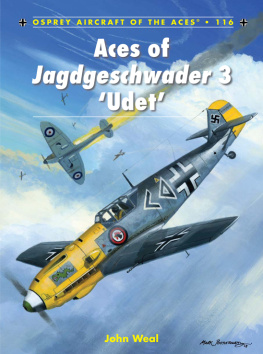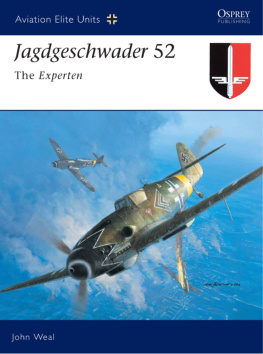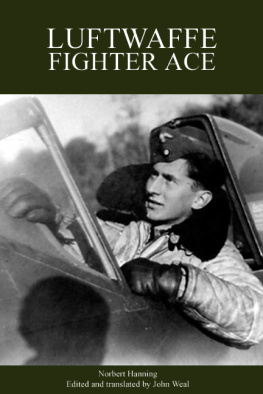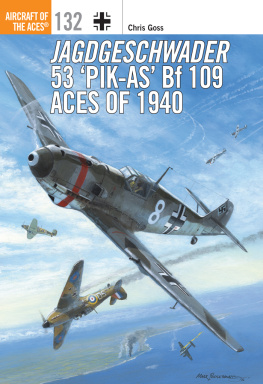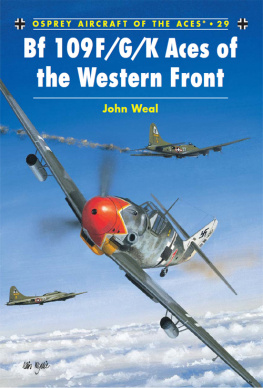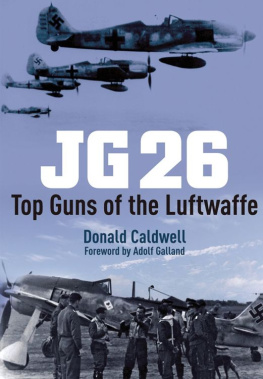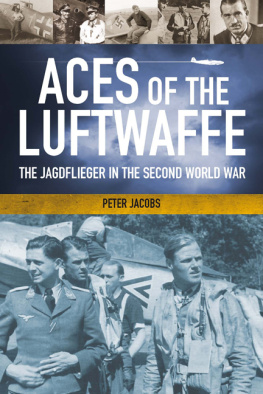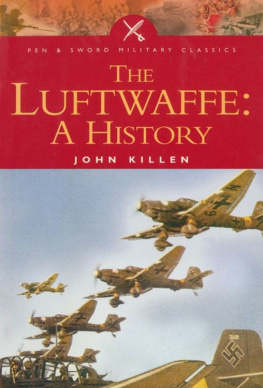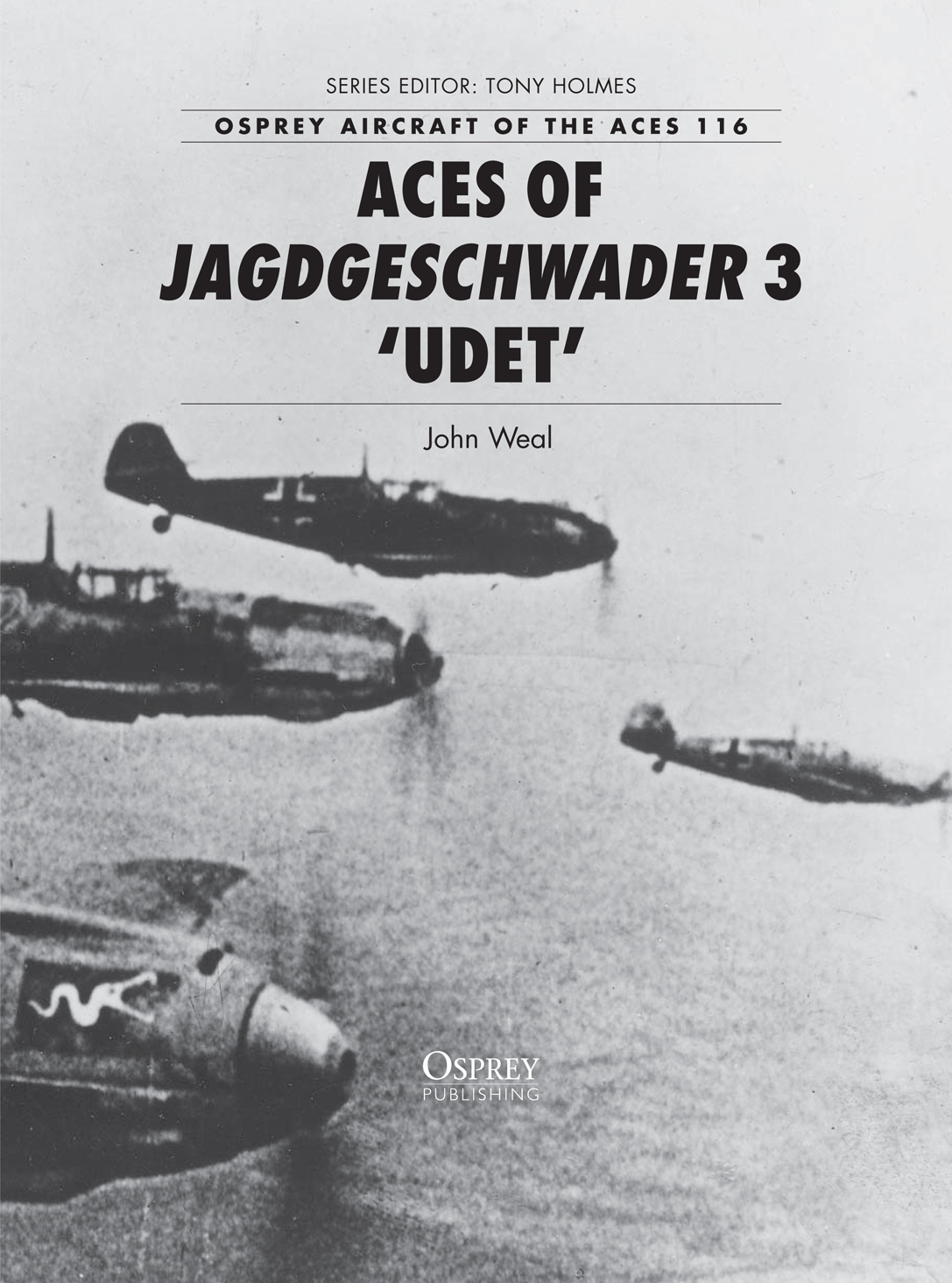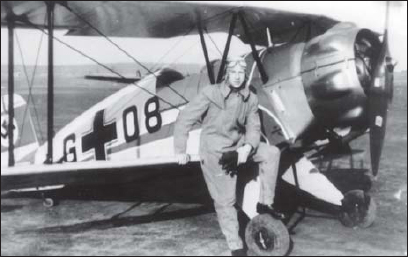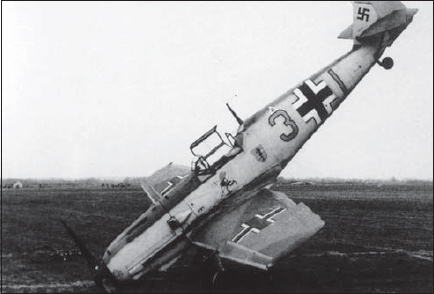A mixed Schwarm of I./JG 3 machines, made up of aircraft from all three Staffeln, patrol over the Channel during the late summer/early autumn of 1940. The Emil in the foreground, White 1, is believed to be the fighter assigned to Oberleutnant Lothar Keller, the Staffelkapitn of 1./JG 3, whose score by mid-September stood at 15
CONTENTS
A SLOW START
O ne of the minor anomalies of the wartime German Luftwaffe was the fact that its most famous dive-bomber unit, Stukageschwader 2 Immelmann, was named after the man who was arguably World War 1s greatest fighter tactician, whereas it was a fighter unit that bore the name of the man who is considered by many to be the founding father of the Third Reichs dive-bomber arm! The reasons behind this apparent illogicality are of no relevance here. Suffice it simply to say that the origins of the fighter unit in question, Jagdgeschwader 3, date back more than five years before the honour title Udet was conferred upon it.
I./JG 232, one of four new Jagdgruppen to be activated on 1 April 1936, was initially set up at Bernburg, some 140 kilometres to the southwest of Berlin. In common with all the other fighter units brought into being during the years leading up to the outbreak of World War 2, this original I./JG 232 was to undergo a complex and bewildering succession of redesignations. Within months it had been renumbered to become I./JG 137, and as such it was later divided into two. Two of its Staffeln were used to establish the experimental I.(leichte Jagd)/Lehrgeschwader (I.(J)/LG 2 of the early war years). The remaining Staffel was then strengthened to form the nucleus of a new I./JG 137 during the latter half of 1938.
By this time a second Gruppe, II./JG 137, had already been activated at Zerbst, just 30 kilometres to the northeast of Bernburg. And on 1 November 1938 the two units were redesignated to become I. and II./JG 231 respectively. They did not retain these identities for long, however. In the final pre-war reshuffle of 1 May 1939, I./JG 231 was incorporated into the new Zerstrer arm as I./ZG 2 (albeit still equipped with single-engined Bf 109Ds), while II./JG 231 finally emerged as I./JG 3 the first (and as yet only) Gruppe of Jagdgeschwader 3.
During the two Gruppens six-month existence, a Geschwaderstab (HQ Staff) had been formed alongside I./JG 231 at Bernburg. Stab JG 231 was commanded by Oberstleutnant Max Ibel, who remained Kommodore after the units renumbering as JG 3.
On 26 August 1939, just six days prior to Hitlers invasion of Poland, Oberstleutnant Ibel had transferred his Stab JG 3 the 90 kilometres eastwards from Bernburg to Brandis. But JG 3 was not intended for service in the coming campaign against Poland. During the opening month of World War 2 the role of Ibels command (still comprising just I./JG 3) was instead to provide the aerial defence of the industrial region of central Germany to the immediate south of Berlin. In the event, this area saw no daylight bomber incursions of any kind, either from the Polish Air Force in the east, or from Britain and France to the west. By the end of September 1939 Stab JG 3 had itself been split into two. Oberstleutnant Ibel took one section to Mnster-Handorf, where it became Stab JG 27, while Oberstleutnant Carl Vieck hitherto the Gruppenkommandeur of I./JG 2 Richthofen led the other back to Zerbst as the new Kommodore of Stab JG 3.

The man in whose honour JG 3 was to be named, Ernst Udet (centre), is seen here in the mid-1930s wearing the uniform of a Flieger-Vizekommodore (Lieutenant-Colonel) of the Deutscher Luftsport-Verband (German Air Sports Association), complete with World War 1 medal ribbons and with the Pour la Mrite around his neck
Posing proudly in front of the pearl-grey and green B 133 Jungmeister (L2+08) that he flew as a member of LG 2s Kunstflugstaffel (Aerobatic squadron), the young Josef Heinzeller was one of a number of LG 2 pilots who subsequently joined JG 3 and rose to become aces
Little more than a month later I./JG 3, which by now had joined the Stab at Zerbst, also underwent a change of command. The veteran Oberstleutnant Otto-Heinrich von Houwald, who had been Kommandeur of the Gruppe since its inception as II./JG 137 in the summer of 1938, was appointed to a training post. His place at the head of I./JG 3 was taken by 27-year-old Hauptmann Gnther Ltzow, an ace of the recent Spanish Civil War.
Ramrod-straight as he shakes hand with his Fhrer, an equally young-looking Gnther Ltzow future Geschwaderkommodore of JG 3 is pictured here during a visit by Hitler to the Werneuchen fighter school on the outskirts of Berlin in the months leading up to the outbreak of war
In early January 1940 Hauptmann Ltzows I./JG 3 was posted to the western front, where it was attached to Stab JG 77. For the next four months the Gruppe occupied a succession of bases in the Rhineland region, often deployed in individual Staffel strength on separate fields some distance apart. This was the period of the Phoney War, or Sitzkrieg, a fact all too clearly reflected in the units as yet pristine war diary, which recorded neither losses nor a single victory.
Meanwhile, back in the heart of the Reich, the operational hiatus that had followed on from the defeat of Poland was being put to good use as the size of the Luftwaffe was rapidly increased. Among the many new units formed during this time were II./JG 3, which was activated under Hauptmann Erich von Selle alongside the Geschwaderstab at Zerbst on 1 February 1940, and Hauptmann Walter Kienitzs III./JG 3, established at Jena, near Weimar, exactly one month later. Not surprisingly perhaps, neither of these two Gruppen achieved any victories during what remained of the Phoney War, although III./JG 3 did suffer the loss of one NCO pilot, whose aircraft crashed in bad weather while on an operational sortie northeast of the Ruhr on 18 April 1940.
Then, in the early hours of 10 May 1940, the uneasy eight-month stalemate that had existed between the forces occupying the Siegfried and Maginot Lines was suddenly shattered by Hitler unleashing his Blitzkrieg against the west. Once again, however, as in the Polish campaign of the previous autumn, Stab JG 3 was held in reserve in central Germany as part of the aerial defences of the industrial regions to the south of Berlin. Together with Hauptmann von Selles II./JG 3, it remained at Zerbst during the opening rounds of the war in the west, awaiting the Allied daylight bombing raids that never came.
During the Phoney War period JG 3 claimed no victories and suffered no combat losses, but there were minor mishaps aplenty, including this one that befell 9.

